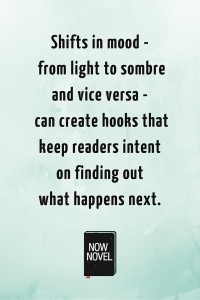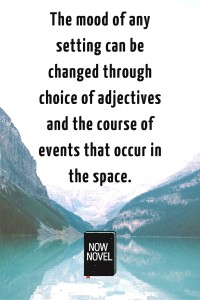Have you ever read a great horror or thriller novel and felt a pervasive sense of the eerie or ominous? How did the writer create that mood? Mood is an aspect of novel writing that is often overlooked. We talk more about specific elements such as character and plot. The mood of your novel emerges out of a combination of these elements: Plot and theme, language, characters and setting. Yet focusing on mood itself as a subject is useful for making sure your story affects readers the way you want it to. Here are tips for writing fiction that establishes mood effectively:
Elicit emotional response: Mood and your readers

The emotional state that your reader enters while reading your novel is the overarching effect of the mood of your writing. You may want your reader to feel happy or sad, frightened or safe, melancholy, nostalgic, hopeful, hopeless, some combination of these emotions or something else entirely.
It's important to remember that the same sequence of events can have wildly different moods depending on your intentions. A character falling down a flight of stairs could be tragic or slapstick and comical, for example. It could make the reader feel empathetic or amused. So your first step is identifying what emotions you want to evoke in your reader. This will depend on:
- Genre: a paranormal romance will usually require a mixture of a romantic and spooky or eerie mood
- Plot: What events do you want to occur in the course of your novel? Does your character experience a great tragedy? Do you want to foreshadow this with a pervasively somber mood or would you prefer to make the event come out of the blue and depart from an upbeat tone so that the narrative is shocking and surprising?
Think about the course of your story in terms of mood and how you could vary mood itself to create high and low points, tension and release. Shifts in mood - from light to sombre and vice versa - can create hooks that keep readers intent on finding out what happens next.
Use individual elements of your story to convey mood convincingly

In novel writing many discrete parts form a whole, ideally a satisfying one. Here are 5 elements of a story and how to convey mood better using them:
- Plot and theme - Plot and theme often are closely linked to mood - the nature of events in your story will determine their feeling and the response they elicit to some extent. You may also want to create a dichotomy between these elements and your readers' emotions however. For example, sometimes writers will take a normally dark subject like death and write a comic novel about it. Creating a strong sense of mood throughout can be as simple as writing three words to describe the mood of each scene as you go, so that you have an overarching effect guiding the language and description you choose.
- Language - The language that you choose can weaken the internal logic of your plot by creating a mood that seems strange. How you describe character and setting has its foundation in word choice. Think about the 'connotations' of words (the feelings and biases they suggest) as well as the denotations (their dictionary definitions). The verbs 'to shuffle' and 'to creep' both mean to move slowly, but the first suggests old age or physical challenges whereas the second suggests stealth. The exact words you choose to describe fictional places, characters and actions carry a lot of subtle, implied meanings so choose with purpose.
- Setting - The mood of any setting can be changed through choice of adjectives and the course of events that occur in the space. A cathedral can be a place of great peace or it can be spooky and overwhelming. A sunny beach will put a reader in a different frame of mind than a gloomy city where it is constantly raining, and a reader will feel different emotions when a story is set in a warm cosy cottage versus a huge faceless office building. Make sure that your setting mirrors, to some extent, your main characters' world views, desires and actions. Having said that, interesting effects can be obtained in making a character wildly out of place and at odds with their immediate environment.
- Character - In writing fiction, characters have an enormous effect on the mood of a piece, particularly the viewpoint character or characters. If the readers spend most of their time in the head of characters who are angry or depressed, that mood will permeate their experience of the book; likewise, if the main characters are generally happy, content and positive, readers' moods will respond accordingly. Again, as with all the other elements above, there are caveats and exceptions; a cheerful serial killer might create a sense of horror for the reader, as it suggests complete remorselessness, while a character's incessant pessimism might be a source of laughs rather than of despair.
Focus on the interplay of story elements
As the above discussion demonstrates, creating mood for readers is not just a matter of how you use one or two elements in your novel. Mood depends on the interplay between those elements and how each part affects and alters the whole. Even though certain plots, themes, characters and settings tend to produce certain types of moods in readers, scenes, events, characters, language and settings can be tweaked to depart from convention too.
Try the 'Mood Creator' in the Now Novel ideas finder to see whether your idea will allow convincing mood.










Definitely the interplaying of the elements is key and why as great as Hemingway App is you can't always listen to it! If you do get too heavy with all the adjectives and then the characters aren't pulling their weight can make things tough.
Ben Wtnb - About 10 years ago
Good point, Ben. I think these apps should always be used sensibly and within reason. It is a fine balance, striking the right amount of action and description.
Bridget At Now Novel - Almost 10 years ago
Location can be key to creating mood. A thriller can be more poignant, where the character moves from insecurity to a better place only to be confronted by the horror of a murder in this newly found haven of happiness. There is a skill in developing the feeling for the reader that impending doom is likely to invade the idyll created, for the hero in the story journey.
Viewtoday - Over 8 years ago
Very true, thank you for contributing this. When creating mood, a lot depends on the associations readers make between particular objects, environments, and relationships between objects and environments (for example, a gun in a school bag will generally be far more tension-causing and concerning than a gun under an adult's belt).
Bridget At Now Novel - Over 8 years ago